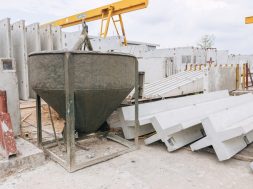BUILDING FUTURE
From creating skyscrapers to addressing the issues of Indian architects not being allowed to practice overseas to challenging the government over policy guidelines, Architect HAFEEZ CONTRACTOR raises his concerns about housing the future population. Edited excerpt from his interview with Subhajit Roy
According to you is architecture an art or science?For me, it’s a mix of both. Architecture can be called an art or science keeping in mind that it’s been done for people, the social angle has to be taken into consideration. You can be a very good architect if you consider buildings as an art object and not a mere structure to be worked upon, but if you have not considered how it’s going to be finally used, you cannot term it architecture; it’ll just remain a sculpture. Therefore, it is very important to consider the human angle. This is how I look at architecture.
In 1982, you started your practice with a staff of only two and today the firm has over 500 employees. How do you see this transition?I don’t see my strength in the number of people and neither do I keep a check on the figures. We just keep on working and if any help is required further with regards to manpower, we keep on hiring. That’s the way I look at it. There is no target set that I have to reach 800 or 1000.
Being in this industry for almost 30 years, how do you see the transition of Indian architecture?Indian architecture has come a long way and we still have a long way to go. India or Indian architects were previously a protected lot. Our country was like a completely isolated country as far as architecture was concerned; but today we are very much a part of the global arena. Indian market is going global.
We have to rise to the challenges and there’s lot to be done as far as education in this field is concerned. India is lagging behind from the professional architecture perspective there is lot to be done in the way we deal with clients and how clients deal with the architects.
Indian market is going global, what are your views on the Indian architects reaching the global level?That’s the saddest part. We have allowed all the international architects to practice in India without a single condition. However if an Indian architect wants to practice in a foreign country, they are restricted from doing so. On a personal level, I have been raising this issue at several forums but nobody seems to be taking cognisance of it.
In fact the council of architecture has agreed to look into it and I hope the matter is taken up very seriously because we should be treated the same way overseas the way we treat international architects and since that’s not been followed, my question is why should we just open our doors and let them in. There should be restrictions on them too, the same restrictions that are put on us. I wanted to start my practice in Singapore and was not allowed. The procedure involved applying for a license and sit for an exam and that too in a stipulated period of time. The council is looking into the matter but any kind of action would require time.
With rising population and constraint of space becoming an issue, is skyscraper the only option?Let me explain from a different perspective. With more population, we need more food. We can grow food grains only on the ground. Human beings can stay high up in the air but food grains cannot be grown anywhere else apart from the ground. Then there is the ecological part that needs to be taken into consideration. Land is one crucial component of our ecosystem which does not grow or cannot be produced; everything else can be made readily available.
Since the last 50 years, we have been talking about low rise development and our minds are focused on the fact that low rise development is the best way of living. I would also love to live in a bungalow, but we have to think about everybody. Most of the government authorities are against higher density because with high density they have to take care of a proper infrastructure. If there is a high density building and no proper infrastructure, for example take the case of a hundred storey building and the drainage burst down below, you will have hundred times more garbage and muck down below and if you have a four storey building and the drainage burst, it does not make any difference, people will ignore the foul and walk away. That’s the first thing that our city governments need to understand. But high rise for a country like ours, which has limited resources as far as food and other things are concerned, is a very apt thing. I am saying ‘limited’ in a manner that you have to think about the future population and resources.
Most of the towns and cities in our country have been constructed either near the river bed or proper valleys. There are large towns coming up and large towns are growing into cities and cities into mega cities. We have to learn how to use our old resources and make proper use of it and don’t eat up farmland because farmland will in turn gobble-up forest land.
You have to live your environment in the same way the ancestors gave it to you. In the same way, we have a responsibility to think about the future generation as well. We just can’t afford to plunder the trees, forest or ground and finish coal etc. People who don’t think about the future generation are not human being; this has been my observation since a very long time.
For instance, let’s have a look at the city of Mumbai. With a population of 18 million people and more than 65 per cent residing in the slums, the city is almost set to touch 30 million by 2025. The question thus remains where will we house the future population? Growing vertical is the only option. There has to be new laws regarding mass housing. Concessions have to be given for mass housing. Out of 18 million, 10 million people are staying in the slums so that’s 10 million and we are almost on the verge of reaching 30 million, where will we house these 22 million population (30 million minus 8 million) in the next 12-14 years. This is a serious issue and nobody seems to be paying heed.
But who are to be blamed?Everybody is keeping mum on the subject. Our approach has become selfish, not thinking about the future generation. That’s not the way; if this continues, we’ll have riots, fights and there will be chaos all around for shelter. I suggest this as a wakeup call for the ministers and bureaucrats. A bureaucrat gets a free house and by the time he retires, he gets a society and a house. He is not aware of the difficulties a common man faces while purchasing a house. Make the ministers drive without a red light – then he will understand what can be done about the roads. We are one of the few countries who provide house for ministers and bureaucrats, no other country does that. These people don’t understand the real life situation and talk big.
As a leading architect, what are your recommendations for addressing this issue?I have always said and I am saying it again that we need to have our housing policies in tune with our economic situations for the population.
Don’t you think the project developers should come forward and take some initiatives?We as architects have no role to play, we are simply draftsman. The main role is a policy, policy makes everything. We can promote affordable housing by making a policy stating each and every builder while making a house has to dedicate some percentage for the lower income group. In return, we can award additional FSI to the builders. That way, the whole problem of low housing of 400 or 450 square feet will be solved in a matter of years. It is irrelevant to think that the government or MHADA are going to take care of it. Private enterprise is the only source which will turn these minuses into a plus. But the bureaucrats and politicians in power are extremely worried and jealous. They think the private players will make money out of it. But making profit out of a business is quite natural. If there is a famine and farmers grow wheat and sell it at a high price he will make money out of it. If you are jealous about that, then you will be in the famine only.
Out of all your projects, which was the most challenging project?Every project is challenging in a different manner and you have to see the challenge. The best thing is don’t give up, apply your mind and you will get a solution.
Your advice to the future architectsI don’t have a one line advice. My suggestion is: don’t take up architecture to make money because there is no profession where you don’t make money. In fact, the person who likes cutting hair and wants to be a barber, it’s better to be a good barber than a bad architect. So, whatever you do, do it well and take up what interests you the most. If you really like creating or designing something, then become an architect. Moreover, you should know what you are doing and why you are doing, if you like doing that, then you will be really good at it. I often say that whole day I am playing, I don’t feel I am working, it’s a play for me, it’s not work.
Cookie Consent
We use cookies to personalize your experience. By continuing to visit this website you agree to our Terms & Conditions, Privacy Policy and Cookie Policy.






